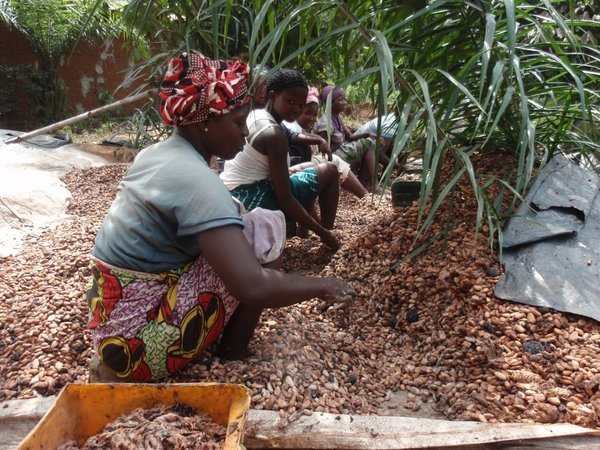- Share this article
- Subscribe to our newsletter
German Initiative on Sustainable Cocoa campaigns for a living income
Cocoa farmers were better off 30 years ago. Since the 1980s, the growing volatility of world prices has led to a steady decline in price levels. The cocoa plantations are obsolescent, and farmers are spending very large amounts of money on fertilisers, seed and saplings. Since yields are nevertheless low, the families resort to the rainforest, where they clear new areas. Also, child labour continues to be anything but a rarity.
The German Initiative on Sustainable Cocoa (GISCO) was started in 2012 to counter this development. It is a joint initiative of the German Federal Ministry of Economic Cooperation and Development (BMZ) and the German Federal Ministry of Food and Agriculture (BMEL), the German sweets and confectionary industry, the German retail grocery trade, and civil society, and now numbers 76 active members. At this year’s members’ assembly of the Initiative, held in Berlin in mid-May, new targets were formulated to improve the living and income situation of cocoa farmers, particularly in West Africa.
A case for nature-friendly intensification
The Royal Tropical Institute of the Netherlands (KIT), Amsterdam/Netherlands, analysed the economic situation of cocoa farmers in West Africa in a 2018 study. Co-author Anna Laven presented some of its results in Berlin/Germany. The study shows that the living situation of the cocoa farmers in Ghana and Côte d’Ivoire is extremely precarious. Above all, Laven explained, there was a lack of money for training, necessary reserves and health. Malnutrition also occurred in some seasons. However, she noted, differences varied considerably among the households, and unlike in Côte d’Ivoire, government healthcare took some of the pressure out of the income situation in Ghana.
Cocoa is usually grown by households headed by men, while households with women in charge are opting increasingly for other crops, the study demonstrates. Most cocoa farmers harvest 450 kilos of cocoa beans – a mere half of what would be possible. This is the reason why they extend their cropland into the rainforest. Laven therefore called for nature-friendly intensification. If the cocoa farmers were able to enhance yield on their own cropland in a nature-friendly manner, the areas cleared would again be available for afforestation, she argues.
There is a whole complex of causes responsible for the weak position of the actors in the cocoa value chain. In many cases, landed property is insecure, and this holds all the more for the situation of the farmers themselves. Often, the farms are too small and the cocoa trees are too old. There is a lack of money for necessary inputs such as fertiliser and herbicides, which is why the cocoa beans are frequently of poor quality. Monoculture and the absence of human rights as well as child labour make things even worse. The study also demonstrates that a higher price alone is not enough to improve the living conditions of the farmers.
Involving the producing countries
Against this background, the Initiative on Sustainable Cocoa adopted twelve individual targets in Berlin to improve the living conditions of the smallholders. They include living incomes for the cocoa farmer households, observing human rights within the cocoa value chain and measures against increasing deforestation.
“We have to become more political,” demanded BMZ Parliamentary State Secretary Maria Flachsbarth. The producing countries had to join the debate on development, for without the participation of the local governments, problems could not be solved in the long run, Flachsbarth argued. However, she also wished to see the perspective of the industrialised countries change. They were not merely purchasers of commodities but clients for the producing countries and should therefore make more demands on them. Clients determined under which conditions products were to be produced and therefore had opportunities to influence processes. “Africa’s future lies in the hands of the Africans,” Flachsbarth said. “However, we are not just spectators but also actors.”
The Living Income model
By calculating the living income, the world-wide alliance Living Income Community of Practice establishes the amount needed locally to ensure a food securing and healthy survival of smallholders. GISCO Managing Director Beate Weiskopft presented the calculations of the alliance for the West African cocoa farmers. Income is compiled according to agricultural income and income from non-agricultural sources. The latter are wages from other sectors as well as remittances from abroad. This actual value is contrasted with a target value that is established as a regionally adjusted value for the areas of food, accommodation, clean water, health, education and small reserves. A negative difference indicates the income gap that needs to be closed.
For example, in Côte d’Ivoire, cocoa contributes 66 per cent of agricultural income on average. Together with non-farm income, the households earn 172 euros a month, so that a gap of 306 euros a month would have to be bridged. In Ghana, at 179 euros a month, this gap is significantly smaller. The sum of new goals set by the forum are to close the gaps.
Fair Trade has used the Living Income model to work out a reference price for cocoa from Côte d’Ivoire. Fair Trade currently pays 2,000 US dollars per tonne. As of October this year, the reference price is to rise to 2,400 USD. In addition, there will be a surcharge of 240 USD that can then be used by the cooperatives for drying plants and school projects.
Roland Krieg, journalist, Berlin/Germany
More information:
The German Initiative on Sustainable Cocoa Website
Study: Demystifying the Cocoa Sector in Ghana and Côte d’Ivoire





Add a comment
Be the First to Comment